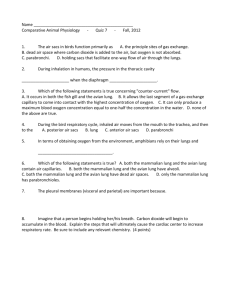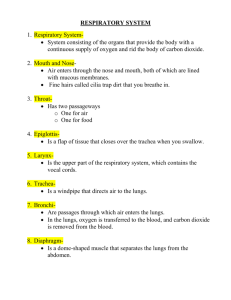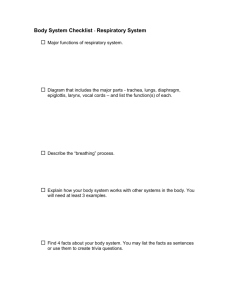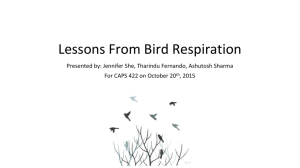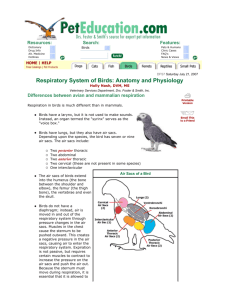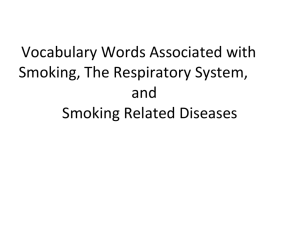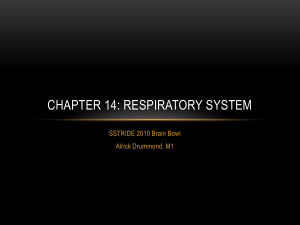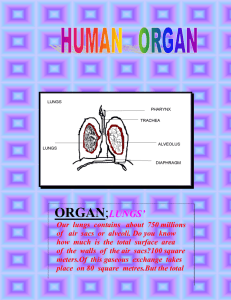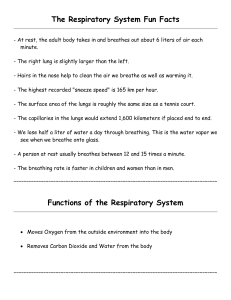Avian Respiration
advertisement
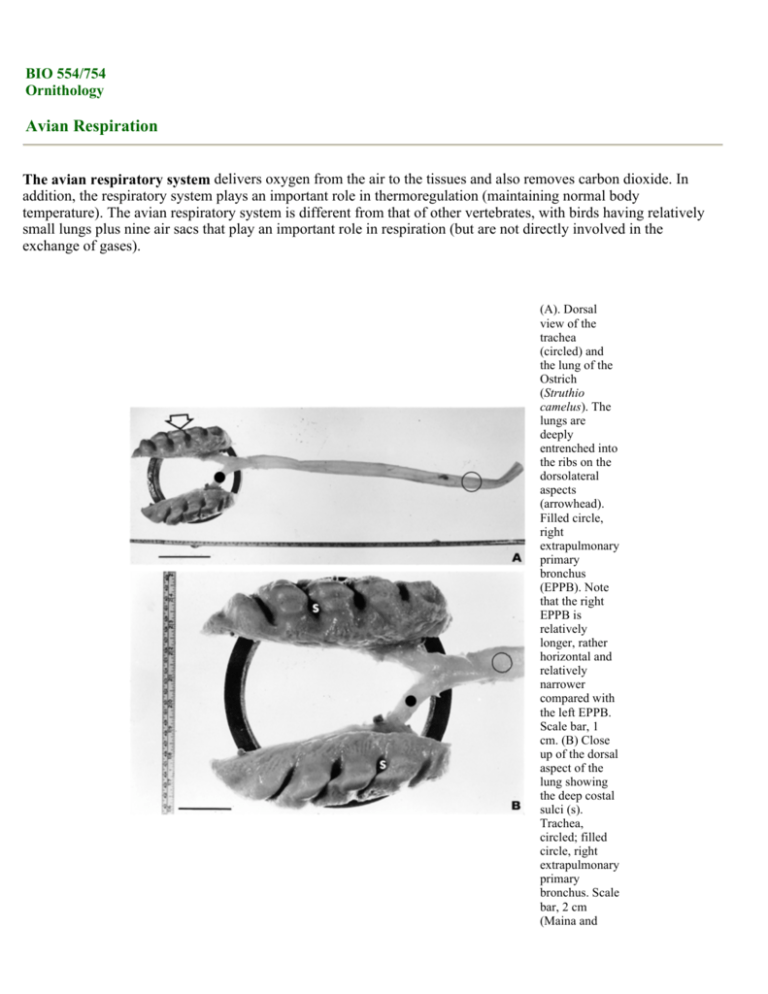
BIO 554/754
Ornithology
Avian Respiration
The avian respiratory system delivers oxygen from the air to the tissues and also removes carbon dioxide. In
addition, the respiratory system plays an important role in thermoregulation (maintaining normal body
temperature). The avian respiratory system is different from that of other vertebrates, with birds having relatively
small lungs plus nine air sacs that play an important role in respiration (but are not directly involved in the
exchange of gases).
(A). Dorsal
view of the
trachea
(circled) and
the lung of the
Ostrich
(Struthio
camelus). The
lungs are
deeply
entrenched into
the ribs on the
dorsolateral
aspects
(arrowhead).
Filled circle,
right
extrapulmonary
primary
bronchus
(EPPB). Note
that the right
EPPB is
relatively
longer, rather
horizontal and
relatively
narrower
compared with
the left EPPB.
Scale bar, 1
cm. (B) Close
up of the dorsal
aspect of the
lung showing
the deep costal
sulci (s).
Trachea,
circled; filled
circle, right
extrapulmonary
primary
bronchus. Scale
bar, 2 cm
(Maina and
Nathaniel
2001).
Used with permission of John Kimball.
The air sacs permit a unidirectional flow of air through the lungs. Unidirectional flow means that air moving
through bird lungs is largely 'fresh' air & has a higher oxygen content. In contrast, air flow is 'bidirectional' in
mammals, moving back & forth into & out of the lungs. As a result, air coming into a mammal's lungs is mixed
with 'old' air (air that has been in the lungs for a while) & this 'mixed air' has less oxygen. So, in bird lungs, more
oxygen is available to diffuse into the blood (avian respiratory system).
Pulmonary air-sac system of a Common Teal (Anas crecca). a. Latex injection (blue) highlighting the location of
air sacs.
b, Main components of the avian flow-through system. Abd, abdominal aire sac; Cdth, caudal thoracic air sac; Cl,
clavicular
air sac; Crth, cranial thoracic air sac; Cv, cervical air sac; Fu, furcula; Hu, humerus; Lu, lung; Lvd, lateral vertebral
diverticula;
Pv, pelvis; and Tr, trachea (From: O'Connor and Claessens 2005).
The alveolar lungs of mammals (Rhesus monkey; A) and parabronchial lungs of birds (pigeon; B) are subdivided
into large
numbers of extremely small alveoli (A, inset) or air capillaries (radiating from the parabronchi; B, inset). The
mammalian respiratory
system is partitioned homogeneously, so the functions of ventilation and gas exchange are shared by alveoli and
much of the lung volume.
The avian respiratory system is partitioned heterogeneously, so the functions of ventilation and gas exchange are
separate in the air sacs
(shaded in gray) and the parabronchial lung, respectively. Air sacs act as bellows to ventilate the tube-like
parabronchi (Powell and Hopkins 2004).
Credit: Zina Deretsky, National Science Foundation
Bird-like respiratory systems in dinosaurs -- A recent analysis showing the presence of a very bird-like pulmonary, or
lung, system in predatory dinosaurs provides more evidence of an evolutionary link between dinosaurs and birds. First
proposed in the late 19th century, theories about the animals' relatedness enjoyed brief support but soon fell out of favor.
Evidence gathered over the past 30 years has breathed new life into the hypothesis. O'Connor and Claessens (2005) make
clear the unique pulmonary system of birds, which has fixed lungs and air sacs that penetrate the skeleton, has an older
history than previously realized. It also dispels the theory that predatory dinosaurs had lungs similar to living reptiles, like
crocodiles.
The avian pulmonary system uses "flow-through ventilation," relying on a set of nine flexible air sacs that act like bellows
to move air through the almost completely rigid lungs. Air sacs do not take part in the actual oxygen exchange, but do
greatly enhance its efficiency and allow for the high metabolic rates found in birds. This system also keeps the volume of
air in the lung nearly constant, a prerequisite for maintaining a level flight path. O'Connor says the presence of an extensive
pulmonary air sac system with flow-through ventilation of the lung suggests this group of dinosaurs could have maintained
a stable and high metabolism, putting them much closer to a warm-blooded existence. "More and more characteristics that
once defined birds--feathers, for example--are now known to have been present in dinosaurs, so, many avian features may
really be dinosaurian," said O'Connor. A portion of the air sac actually integrates with the skeleton, forming air pockets in
otherwise dense bone. The exact function of this skeletal modification is not completely understood, but one explanation
theorizes the skeletal air pockets evolved to lighten the bone structure, allowing dinosaurs to walk upright and birds to fly.
Most birds have 9 air sacs:
z
z
z
z
z
one interclavicular sac
two cervical sacs
two anterior thoracic
sacs
two posterior thoracic
sacs
two abdominal sacs
Functionally, these 9 air sacs
can be divided into anterior
sacs (interclavicular, cervicals,
& anterior thoracics) &
posterior sacs (posterior
thoracics & abdominals). Air
sacs have very thin walls with
few blood vessels. So, they do
not play a direct role in gas
exchange. Rather, they act as a
'bellows' to ventilate the lungs
(Powell 2000).
Source: http://numbat.murdoch.edu.au/Anatomy/avian/fig3.2.GIF
Air sacs and axial pneumatization in an extant avian. The body of bird in left lateral view, showing the cervical (C), interclavicular (I),
anterior thoracic (AT), posterior thoracic (PT), and abdominal (AB) air sacs. The hatched area shows the volume change during exhalation.
The cervical and anterior thoracic vertebrae are pneumatized by diverticula of the cervical air sacs. The posterior thoracic vertebrae and
synsacrum are pneumatized by the abdominal air sacs in most taxa. Diverticula of the abdominal air sacs usually invade the vertebral
column at several points. Diverticula often unite when they come into contact, producing a system of continuous vertebral airways
extending from the third cervical vertebra to the end of the synsacrum. Modified from Duncker 1971 (Wedel 2003).
Computerized axial tomogram of an awake, spontaneously
breathing goose; air is darkest. A large percentage of the
bird's body is filled with the several air sacs. Upper left: At
the level of the shoulder joints (hh, humeral head) is the
intraclavicular air sac (ICAS), which extends from the heart
cranially to the clavicles (i.e., furcula or wishbone). S,
sternum; FM, large flight muscles with enclosed air sac
diverticula, arrowheads; t, trachea. Upper right: At the level
of the caudal heart (H) is the paired cranial thoracic air sacs
(TAS). Arrowhead points to the medial wall of the air sac
(contrast enhanced with aerosolized tantalum powder). The
dorsal body cavity is filled with the lungs, which are tightly
attached to the dorsal and lateral body wall. V, thoracic
vertebrae. Lower left: At the level of the knees (K) is the
paired caudal thoracic air sacs (PTAS) and paired abdominal
air sacs, with the abdominal viscera (AV) filling the ventral
body cavity. The membrane separating the abdominal air sacs
from one another (arrowhead) and from the caudal thoracic
air sacs (arrows) can be seen. Lower right: At the level of the
caudal pelvis, the abdominal air sacs, which extend to the
bird's tail, can be seen. Arrow, membrane separating
abdominal air sacs (Brown et al. 1997).
Birds can breathe through the mouth or the nostrils (nares). Air entering these openings (during inspiration) passes
through the pharynx & then into the trachea (or windpipe). The trachea is generally as long as the neck. However,
some birds, such as cranes, have an exceptionally long (up to 1.5 m) trachea that is coiled within the hollowed keel
of the breastbone (shown below). This arrangement may give additional resonance to their loud calls (check this
short video of calling Sandhill Cranes).
Sandhill Cranes calling in flight
The typical bird trachea is 2.7 times longer and 1.29 times wider than that of similarly-sized mammals. The net
effect is that tracheal resistance to air flow is similar to that in mammals, but the tracheal dead space volume is
about 4.5 times larger. Birds compensate for the larger tracheal dead space by having a relatively larger tidal
volume and a lower respiratory frequency, approximately one-third that of mammals. These two factors lessen the
impact of the larger tracheal dead space volume on ventilation. Thus, minute tracheal ventilation is only about 1.5
to 1.9 times that of mammals (Ludders 2001).
Examples of tracheal loops found in Black Swans (Cygnus atratus), Whooper
Swans (Cygnus cygnus), White Spoonbills (Platalea leucorodia), Helmeted Curassow (Crax pauxi),
and Whooping Cranes (Grus americana).
Source: http://www.ivis.org/advances/Anesthesia_Gleed/ludders2/chapter_frm.asp
The trachea bifurcates (or splits) into two primary bronchi at the syrinx. The syrinx is unique to birds & is their
'voicebox' (in mammals, sounds are produced in the larynx). The process by which the syrinx produces sounds will
be covered later in the course. The primary bronchi enter the lungs & are then called mesobronchi. Branching off
from the mesobronchi are smaller tubes called ventrobronchi. The ventrobrochi, in turn, lead into the still smaller
parabronchi. Parabronchi can be several millimeters long and 0.5 - 2.0 mm in diameter (depending on the size of
the bird) (Maina 1989) and their walls contain hundreds of tiny, branching, & anastomosing 'air capillaries'
surrounded by a profuse network of blood capillaries (Welty & Baptista 1988).
Semi-schematic drawing of the lung-air sac system in situ. The cranial half of the dorsobronchi (4) and the
parabronchi (6) has been removed. 1 trachea, 2 primary bronchus, 3 ventrobronchi with the connections into (A)
cervical, (B) interclavicular and (C) cranial thoracic air sacs, 5 laterobronchus and caudal primary bronchus open
into (D) posterior thoracic and (E) abdominal air sacs (From: Duncker 2004).
Three-dimensional reconstruction of the gas-exchange region.
AC = air capillaries. Several air capillaries coalesce into an
infundibulum (INF) (Brown et al. 1997).
In this cross-section, note the intertwined
network of blood capillaries, labeled with the
presence of erythrocytes (*), and air capillaries
(AC) that make up the parabronchi's mantle of
gas-exchange tissue (Brown et al. 1997).
Morphology of a chicken lung.
Light microscopy (top image)
and electron microscopy (bottom
two images) of a chicken lung
depicting the respiratory system
of birds. In the bird lung, air
capillaries (Ac) run along with
blood capillaries forming the
blood-air barrier that is typically
< 0.2 µm in thickness. The
barrier (shown in the bottom
image) separates the lumen of the
Ac (*) from the red blood cells
(RBC) in the blood capillaries
and consists of a mostly
continuous surfactant layer
(arrows), thin cytoplasmic
processes of epithelial cells (Ep),
a common basal membrane
(Bm), and the endothelial cells of
the blood capillary (En).
Surfactant is a mixture of lipids
and proteins that acts in the air
capillaries of avian lungs both as
an "antiglue" (preventing the
adhesion of respiratory surfaces
that may occur when the lungs
collapse, e.g., during diving,
swallowing of prey or on
expiration) and to prevent liquid
influx into the lungs (Daniels et
al. 1998). Magnifications: top
image - ×270; middle image ×1,600; bottom image - ×88,000
(Image from Bernhard et al.
2001).
In birds, the thickness of the blood-gas barrier in the 7.3 g Violet-eared Hummingbird (Colibri coruscans) is 0.099
µm, whereas that of an immature 40-kg Ostrich (Struthio camelus) is 0.56 µm; the body mass factorial difference is
5 x 103 and that of the thickness of the barrier is 6 (Maina and West 2005).
Relationship between the harmonic mean thickness of the blood-gas barrier (the thickness of the barrier that affects
the diffusion of oxygen from air capillaries into blood capillaries) against body mass in the lungs of bats, birds, and
nonflying mammals. Birds have particularly thinner barriers than bats and non-flying mammals
(Maina 2000).
Light micrographs of a portion of the lung of a chicken (A) and rabbit (B).
Note the small diameter of the air capillaries in the chicken lung vs. that of the rabbit alveoli (same magnification).
(A) In the chicken lung, pulmonary capillaries are supported by 'struts' of epithelium (arrows). (B) In the rabbit
lung,
pulmonary capillaries are suspended in the large spaces between alveoli (Watson et al. 2007).
It's within these 'air capillaries' that the exchange of gases (oxygen and carbon dioxide) between the lungs & the
blood occurs. The parabronchi then lead into larger dorsobronchi which, in turn, lead back into mesobronchi.
Source: http://wwwvet.murdoch.edu.au/Anatomy/avian/fig3.1.GIF
So, how does air flow through the avian lungs & air sacs during respiration?
Air flow through the avian respiratory system during inspiration (a) and expiration (b).
1 - interclavicular air sac, 2 - cranial thoracic air sac, 3 - caudal thoracic air sac, 4 - abdominal air sac
(From: Reese et al. 2006).
Respiratory airflow in avian lungs. Filled and open arrows denote direction of air flow during inspiration (filled
arrows) and expiration (open arrows), respectively. Relative thickness of the arrows indicates the proportion of air
streaming through the different areas of the respiratory system during the respiratory cycle. Dotted arrows indicate
the volume changes of air sacs. In bird lungs (A), most air directly enters the caudal air sacs during inspiration
(thick black arrow), whereas a lesser part flows through the parabronchi/air capillaries into cranial air sacs (thin
black arrows). During expiration the major part of inspired air streams from the reservoirs (caudal air sacs, thick
open arrows) through the parabronchi/air capillaries into major distal airways, where it mixes with the
deoxygenated respiratory gas stored in cranial air sacs during the inspiratory phase. Consequently, respiratory gas
flow through the parabronchi, atria, and the gas-exchanging air capillaries is unidirectional and continuous during
both inspiration and expiration. This principle is achieved by cranio-caudal pressure gradients in the respiratory
system changing between inspiration and expiration and the consecutive opening and closing of valve systems
between mesobronchi/air sacs and the parabronchi (not indicated in the figure). Hence, airflow is constant and high
in the parabronchi, atria, and the gas-exchanging air capillaries (From: Bernhard et al. 2004).
Surfactant SP-B (in the figure above) is mixture of phospholipids and specific proteins that functions to maintain
airflow through the 'tubes' of the avian respiratory system. Surfactant SP-A has only been detected in the
mesobronchi of birds. SP-A plays an important role in innate host defense and regulation of inflammatory processes
and may be important in the mesobronchi because air flow is slower and small particles could tend to accumulate
there (see figure below). Surfactant SP-C is not found in the avian respiratory system (or, if so, in very small
quantities), but is found in the alveoli of mammals along with SP-A and SP-B. Because the mammalian respiratory
system (below) includes structures that are collapsible (alveoli) and areas with low airflow, all three surfactants are
important for reducing surface tension and innate host defense (Bernhard et al. 2004).
Airflow in mammalian lungs is bidirectional during the respiratory cycle, with highly reduced airflow
in peripheral structures, i.e., bronchioles and, particularly, the gas-exchanging alveoli. Consequently, small particles
(< 1 µm)
that enter the alveoli may sediment, making a system of first line of defense necessary, comprising alveolar
macrophages
(white blood cells), SP-A, and (phospholipid) regulators of inflammatory processes (From: Bernhard et al. 2004).
A: A high-power view of a foreign particle (p) being engulfed by an epithelial cell (e) in an avian lung.
Arrows, elongated microvilli. B: Surface of an atrium of the lung of the domestic fowl showing red blood
cells with one of them (r) being engulfed by the underlying epithelial cell (arrow): e, epithelial surface; m, a free
(surface) macrophage. Scale bars: A = 0.5 µm; B = 10 µm (From: Nganpiep and Maina 2002).
Air flow is driven by changes in pressure within the respiratory system:
z
During inspiration:
{ the sternum moves forward & downward while the vertebral ribs move cranially to expand the sternal
ribs & the thoracoabdominal cavity (see diagram below). This expands the posterior & anterior air sacs
(see 1 above) & lowers the pressure, causing air to move into those air sacs.
Air from the trachea & bronchi moves into the posterior air sacs &, simultaneously,
air from the lungs moves into the anterior air sacs.
Changes in the position of the thoracic skeleton during breathing in a bird. The solid lines represent
thoracic position at the end of expiration while the dotted lines show the thoracic position
at the end of inspiration (Source: http://www.ivis.org/advances/Anesthesia_Gleed/ludders2/chapter_frm.asp).
Schematic representation of the right paleopulmonic lung and air sacs of a bird and the pathway of
gas flow through the pulmonary system during inspiration and expiration. For purposes of clarity, the neopulmonic lung
is not shown. The intrapulmonary bronchus is also known as the mesobronchus. A - Inspiration. B - Expiration
Source: http://www.ivis.org/advances/Anesthesia_Gleed/ludders2/chapter_frm.asp
z
During expiration:
{ the sternum moves backward & upward & the vertebral ribs move caudally to retract the sternal ribs &
reduce the volume of the thoracoabdominal cavity. The reduces the volume of the anterior & posterior
air sacs (see 2 & 4 above), causing air to move out of those sacs.
Air from the posterior sacs moves into the lungs &, simultaneously,
air from the anterior sacs moves into the trachea & out of the body.
So, air always moves unidirectionally through the lungs and, as a result, is higher in oxygen content than, for
example, air in the alveoli of mammals.
Role of uncinate processes and
associated muscles in avian respiration
-- Codd et al. (2005) examined the
activity of three muscles associated with
the uncinate processes, (1) external
intercostal, (2) appendicocostalis and (3)
external oblique (labeled in drawing to
the left) examined using patch and sewthrough electrodes during sitting,
standing and moderate speed treadmill
running in a giant Canada Goose. The
external intercostal muscles demonstrated
no respiratory activity, being active only
during running, suggesting they play
some role in trunk stabilisation. The
appendicocostalis and external oblique
muscles are respiratory muscles, being
active during inspiration and expiration,
respectively. The activity of the
appendicocostalis muscle increased when
sternal movements were restricted, which
suggests activity of these muscles may be
particularly important during prolonged
sitting such as during egg incubation.
Codd et al. (2005) suggest that the
uncinate processes in birds facilitate
movements of the ribs and sternum
during breathing and therefore are
integral to the breathing mechanics of
birds.
Ultra-Low Oxygen Could Have Spurred Bird Breathing System -- Recent evidence suggests that oxygen levels
were suppressed worldwide 175 - 275 million years ago, low enough to make breathing the air at sea level feel like
respiration at high altitude. Peter Ward, a University of Washington paleontologist, theorizes that low oxygen and
repeated short but substantial temperature increases because of greenhouse warming sparked two major massextinction events. In addition, he believes the conditions spurred the
development of an unusual breathing system in Saurischian dinosaurs.
Rather than having a diaphragm to force air in and out of lungs, the
Saurischians had lungs attached to a series of thin-walled air sacs that appear
to have functioned something like bellows to move air through the body.
This breathing system, still found in today's birds, made the Saurischian
dinosaurs better equipped than mammals to survive the harsh conditions in
which oxygen content of air at the Earth's surface was only about half of
today's 21%. "The literature always said that the reason birds had sacs was
so they could breathe when they fly. But I don't know of any brontosaurus
that could fly," Ward said. "However, when we considered that birds fly at altitudes where oxygen is significantly
lower, we finally put it all together with the fact that the oxygen level at the surface was only 10 - 11% at the time
the dinosaurs evolved. That's the same as trying to breathe at 14,000 feet. If you've ever been at 14,000 feet, you
know it's not easy to breathe," he said.
Ward presented his ideas at the 2003 annual meeting of the American Geological Society in Seattle. See:
http://www.nature.com/nsu/031103/031103-7.html & http://www.washington.edu
Exchange of gases:
z
z
In the avian lung, oxygen diffuses (by simple diffusion) from the 'air capillaries' into the blood & carbon
dioxide from the blood into the 'air capillaries'
Air (passing through the parabronchi) & blood (moving through capillaries) travel at right angles to each
other. This is referred to as cross-current flow. Cross-current exchange is very efficient, with oxygen &
carbon dioxide pressure gradients maintained along the entire length of the parabronchus-capillary
'connection.'
Diagram of parabronchial
anatomy, gas-exchange region of
the bird's lung-air-sac respiratory
system. The few hundred to
thousand parabronchi, one of
which is fully shown here, are
packed tightly into a hexagonal
array. The central parabronchial
lumen, through which gas flows
unidirectionally during both
inspiration and expiration (large
arrows) is surrounded by a mantle
(m) of gas-exchange tissue
composed of an intertwined
network of blood and air
capillaries. Several air capillaries
coalesce into a small manifold, i.e.,
the infundibulum (arrowheads),
several of which in turn open into
atria (*) found along the
parabronchial lumen. Air moves
convectively through the
parabronchial lumen, while O2
diffuses radially (CO2 diffuses
centrally) into the air capillary
network. Blood flows centrally
from the pulmonary arteries (a)
located along the periphery of the
parabronchi to pulmonary veins
located along the parabronchial
lumen, which then are drained
back to the peripheral veins (v)
(Modified from Duncker 1971 by
Brown et al. 1997).
Top: Schematic of air flow (large arrows) and blood flow (small arrows) patterns constituting the cross-current gas-exchange mechanism
operating in the avian lung. Note the serial arrangement of blood capillaries running from the periphery to the lumen of the parabronchus
and the air capillaries radially departing from the parabronchial lumen. Bottom: Pressure profiles of O2 and CO2 from initial-parabronchial
(PI) to end-parabronchial values (PE); and in blood capillaries from mixed venous (Pv) to arterial blood (Pa). The PO2of arterial blood is
derived from a mixture of all serial air-blood capillary units and exceeds that of PE. In mammals, the PaO2 cannot exceed that of endexpiratory gas (i.e., PE) (Brown et al. 1997).
Control of Ventilation:
Ventilation and respiratory rate are regulated to meet the demands imposed by changes in metabolic activity (e.g.,
rest and flight) as well as other sensory inputs (e.g., heat and cold). There is likely a central respiratory control
center in the avian brain, but this has not been unequivocally demonstrated. As in mammals, the central control area
appears to be located in the pons and medulla oblongata with facilitation and inhibition coming from higher regions
of the brain. It also appears that the chemical drive on respiratory frequency and inspiratory and expiratory duration
depend on feedback from receptors in the lung as well as on extrapulmonary chemoreceptors, mechanoreceptors,
and thermoreceptors (Ludders 2001).
Central chemoreceptors affect ventilation in response to changes in arterial PCO2 and hydrogen ion concentration.
Peripheral extrapulmonary chemoreceptors, specifically the carotid bodies (located in the carotid arteries), are
influenced by PO2 and increase their discharge rate as PO2 decreases, thus increasing ventilation; they decrease their
rate of discharge as PO2 increases or PCO2 decreases. These responses are the same as those observed in mammals.
Unlike mammals, birds have a unique group of peripheral receptors located in the lung called intrapulmonary
chemoreceptors (IPC) that are acutely sensitive to carbon dioxide and insensitive to hypoxia. The IPC affect rate
and volume of breathing on a breath-to-breath basis by acting as the afferent limb of an inspiratory-inhibitory reflex
that is sensitive to the timing, rate, and extent of CO2 washout from the lung during inspiration (Ludders 2001).
Respiration by Avian Embryos
During avian development there are three sequential stages of
respiration (Tazawa 1987): prenatal (embryonic), paranatal
(hatching), and postnatal (posthatching). During the prenatal stage
respiratory gas exchange occurs via diffusion between the external
environment and the initial gas exchanger (i.e., the area vasculosa, or
the region of blood island formation and forerunner of the
chorioallantoic membrane) in early embryonic life and later the
vascular bed of the chorioallantois. The paranatal stage starts when
the beak penetrates into the air pocket (air cell) between the inner and
outer shell membranes (both internal to shell; i.e., internal pipping)
this occurs during the last 2-3 days of incubation. During this stage,
the lungs begin to replace the chorioallantois as the gas exchanger, yet
diffusion remains the major mechanism moving gas across the shell.
The postnatal stage begins when the beak penetrates the shell (i.e.,
external pipping) (Brown et al. 1997).
Chicken embryo
Literature Cited:
Source: www.ece.utexas.edu/~bevans/courses/ee381k/
lectures/Tomography/milner/sld003.htm
Bernhard, W., A. Gebert, G. Vieten, G. A. Rau1, J. M. Hohlfeld, A. D. Postle, and J. Freihorst. 2001. Pulmonary surfactant in birds:
coping with surface tension in a tubular lung. Am J Physiol - Regulatory Integrative and Comparative Physiology 281: R327-R337.
Bernhard, W., P. L. Haslam, and J. Floros. 2004. From birds to humans: new concepts on airways relative to alveolar surfactant. American
Journal of Respiratory Cell and Molecular Biology 30: 6-11.
Brown, R.E., J. D. Brain, and N. Wang. 1997. The Avian Respiratory System: A Unique Model for Studies of Respiratory Toxicosis and
for Monitoring Air Quality. Environ Health Perspectives 105:188-200.
Codd, J. R., D. F. Boggs, S. F. Perry, and D. R. Carrier. 2005. Activity of three muscles associated with the uncinate processes of the giant
Canada Goose Branta canadensis maximus. Journal of Experimental Biology 208:849-857.
Daniels, C.B., O. V. Lopatko, and S. Orgeig. 1998. Evolution of surface activity related functions of vertebrate pulmonary surfactant. Clin
Exp Pharmacol Physiol. 25:716-721.
Duncker, H.-R. 1971. The lung air sac system of birds. Advances in Anatomy, Embryology, and Cell Biology 45: 1–171.
Duncker, H.-R. 2004. Vertebrate lungs: structure, topography and mechanics: A comparative perspective of the progressive integration of
respiratory system, locomotor apparatus and ontogenetic development. Respiratory Physiology & Neurobiology 144: 111-124.
Ludders, J.W. 2001. Inhaled Anesthesia for Birds. In: Recent Advances in Veterinary Anesthesia and Analgesia: Companion Animals (R.
D. Gleed and J. W. Ludders, eds.). International Veterinary Information Service, Ithaca, NY.
(www.ivis.org/advances/Anesthesia_Gleed/ludders2/chapter_frm.asp)
Maina, J.N. 1989. The morphometry of the avian lung. Pp. 307-368 in Form and Function in Birds (A.S. King and J. McLelland, eds.).
Academic Press, London.
Maina, J. N. 2000. Comparative respiratory morphology: Themes and principles in the design and construction of the gas exchangers.
Anatomical Record 261: 25-44.
Maina, J. N. and John B. West. 2005. Thin and strong! The bioengineering dilemma in the structural and functional design of the bloodgas barrier. Physiol. Rev. 85: 811-844.
Maina, J. N. and C. Nathaniel. 2001. A qualitative and quantitative study of the lung of an ostrich, Struthio camelus. Journal of
Experimental Biology 204: 2313-2330.
Nganpiep, L. N. and J. N. Maina. 2002. Composite cellular defence stratagem in the avian respiratory system:
functional morphology of the free (surface) macrophages and specialized pulmonary epithelia. Journal of
Anatomy 200: 499-516.
O'Connor, P. M. and L. P. Claessens. 2005. Basic avian pulmonary design and flow-through ventilation in non-avian theropod dinosaurs.
Nature 436:253-256.
Powell, F.L. 2000. Respiration. Pp. 233-264 in Avian Physiology, fifth edition (G. Causey Whittow, ed.). Academic Press, New York, NY.
Powell, F. L. and S. R. Hopkins. 2004. Comparative physiology of lung complexity: implications for gas exchange.
News in Physiological Science 19:55-60.
Reese, S., G. Dalamani, and B. Kaspers. 2006. The avian lung-associated immune system: a review. Vet. Res. 37: 311-324.
Tazawa, H. 1987. Embryonic respiration. Pp. 3 - 24 in Bird respiration, vol. 2 (T.J. Seller, ed.). CRC Press, Boca Raton, FL.
Watson, R. R., Z. Fu, and J. B. West. 2007. Morphometry of the extremely thin pulmonary blood-gas barrier in the chicken lung. Am J
Physiol Lung Cell Mol Physiol (November 17, 2006), in press (available early online).
Wedel, M.J. 2003. Vertebral pneumaticity, air sacs, and the physiology of sauropod dinosaurs. Paleobiology 29: 243–255.
Welty, J.C. and L. Baptista. 1988. The life of birds, fourth edition. Saunders College Publishing, New York, NY.
Useful links:
How Animals Work: Avian Respiratory Dynamics Animation
More lecture notes:
Energy Balance & Thermoregulation
Back to BIO 554/754 Syllabus
